Most of you know that I free-hand my feathers 97.5% of the time because of the tight deadlines I work with. I generally don’t like to spend the extra time marking my quilt tops — there are periods of time I would only sleep only 3-4 hours a night for a few nights in order to get a quilt done. You get the idea.
Today, I will share with you my trick for free-handing curvy feather plumes that I use most of the time. My goal is to always come up with tricks to still quilt with decent result within the limited allotted time I have for my magazine quilts.
I start stitching like normal, until I come to and slow down at the entrance of the curve. You know, like when you slow down turning into a curve while driving.
I. In order to achieve the best result, I mentally divide that curve into four quadrants, and try to keep the number of feathers somewhat even from quadrant to quadrant (#1).
II. I also stitch much shorter feathers when I need to orient the feathers in a different directions from the one they start out with (#2). #2 is the KEY to turning your feathers within a curve! To pack in more feathers, you would need to turn approximately at the half “circle” – not too early, or too late.
You see what I mean? Am I even making half an ounce of sense here? This picture below shows the BACK of a quilt. You will have plenty of plumes to analyze to see where my four-quadrant rule is or isn’t applied. :)
As a comparison, this feather plume does not subscribe to my four quadrant rule. It does have slightly shorter feathers at the curves where it turns. It doesn’t look bad. But I am not able to pack in as many feathers, and as a result, it doesn’t look as sophisticated as the plume done with the four-quadrant rule.
So, you ask …. “What do you do if you forget to apply the four-quadrant rule when you are free-handing your feathers away? Do you take the stitches out?” My answer would be “No taking stitches out necessary. I would just move on and try again with a new plume.” If you study the picture below closely, you will see what I mean. All the feathers are free-handed on this quilt.
Curvy feather plumes make a stunning quilting statement! Give them a try – you will soon be addicted, like I am! :)
Happy Feathering, Friends! In case you have missed my past Thread Talk posts on feathers, they are here, here and here. Till next time!


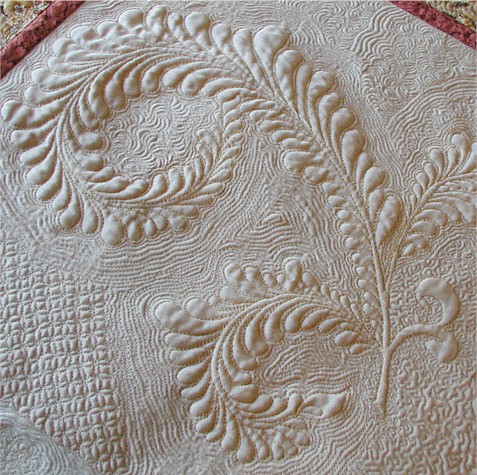

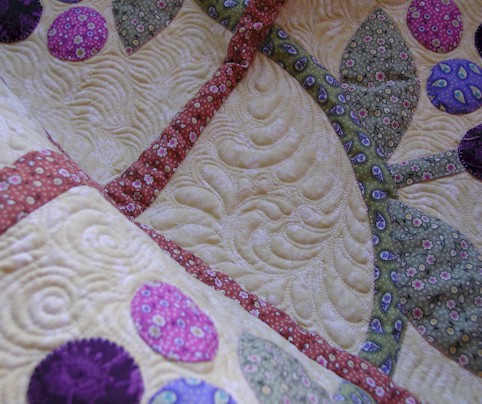
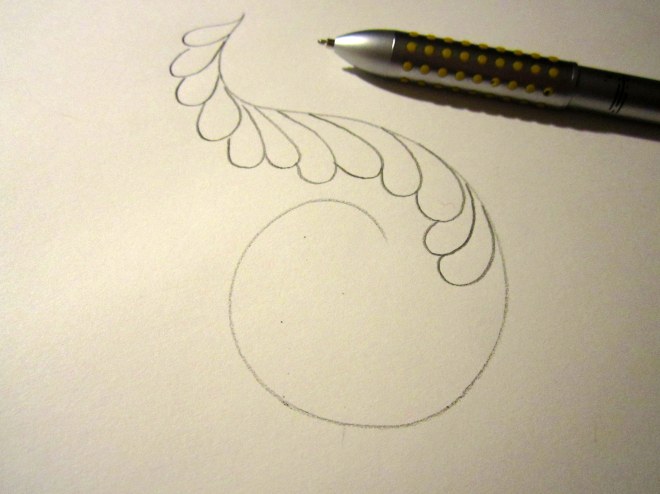
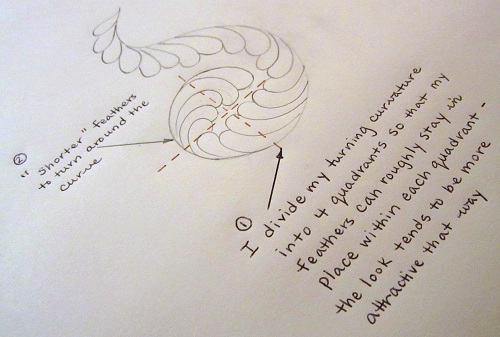

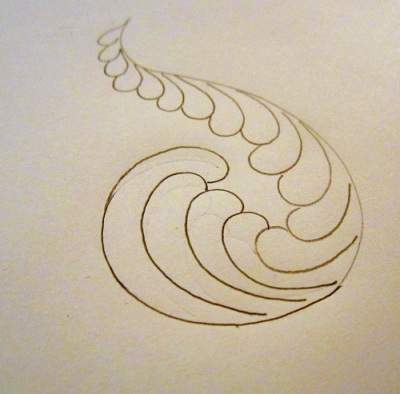
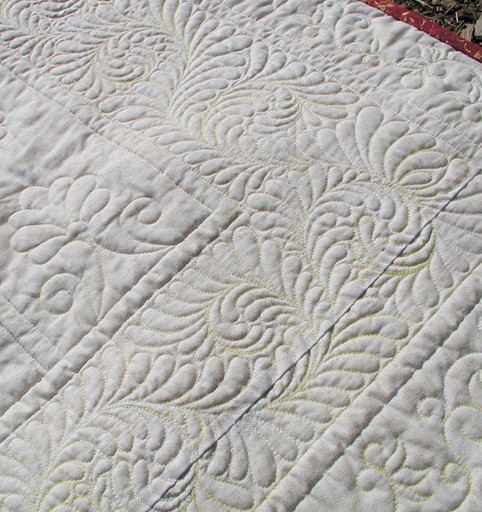
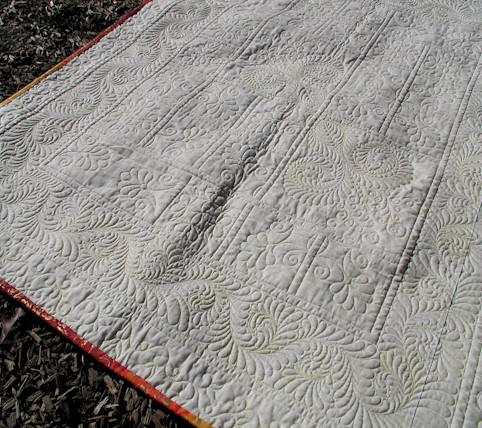

Just beautiful! Do you quilt on a home machine or a long arm?
Hi Candy,
I quilt on a home machine. :)
WS
Wow! I can see I have alot more practice ahead of me! Feathers scare me. :-(
WOW! These are stunning:) You do gorgeous work. And your descriptions and instructions make sense to me
Thanks for sharing all the helpful info, Wendy. Gorgeous, as always!
thank you for another great lesson! I am always amazed at what you accomplish on your Bernina!
:-}pokey
thank you again for some great advice… such lovely feathers
Hugz
Thanks for the lesson. It really helps when you break down the process. I can’t wait to practice!
When you fill a quilt with feathers, do you have a plan in mind with respect to direction and fillin space or is this just totally random free feathers moving right along as it goes?
I love your feathers. Beautiful.
Fabulous as always. Thanks so much for explaining how you “see” the layout. Your feathers are so effective in your quilts. I appreciate your sharing the details.
Simply amazing. You make it look so easy! Won’t you come to our Modern Quilt Guild meeting tonight and give the free motion quilting program, instead of me!?
Thank you so much for this one Wendy! I love feathers and this trick for doing the curves is GREAT. The examples and the sketches explain it perfectly :D
Another beauty and great instructions. Thank you!
This is wonderful — the sketches you drew are REALLY helpful!
I’m not ready for feathers yet — but! — I signed up to take my first ever machine quilting CLASS next month! I’ve decided there is only so much I can learn from books and blogs. I need someone to look over my shoulder and tell me what I’m doing wrong. I wish I could come take classes from you, Wendy! :-)
This is beyond me, but it is indeed stunning!
Incredibly beautiful work, as always, & *super* helpful hints!! Thank you so much.
Thread Talk Sewing Machine #33-Pictures would not open in email.
Truly enjoy your posts. Jeanene Weiland, Bentonville, AR
Thank you for sharing your secrets. Knowing you do this on a domestic sewing machine is inspiration that I could too do this (maybe!). I so enjoy reading your posts every day.
Oh wow I only wish the feather fairy would visit me LOL.
Thanks for the instruction, but I need to learn to draw on paper first and I am not an artist. Hugs Bunny
Ivoryspring,
Truly admire your beautiful work and appreciate all your tips! I have searched through all your ‘thread talks” trying to find out whether you use a bsr or free motion foot to do all this but can’t find anything other than a bsr. To know this answer would be so helpful, i have both and want to really get started practicing. Thank you so much.
Judy
Hi Judy,
Thanks for visiting! I do use BSR, and have found it helpful. But I have also come across students that find it easier to quilt without it. In the end, I think it’s a matter of personal preference. I use my an open toe foot attachment that goes with the BSR.
Pingback: All I can hear is…. | amherst thread tales
I think your sewing machine speaks a different language than mine! Your quilting is incredible. I am in awe!
Oh, Wendy — you make it sound so achievable! I know I’d never be able to do that!
The ‘feather thing’ is so interesting and very individual! I find I form the plumes as you have shown us and combine Leah Day’s and Diane Gaudynski’s techniques in other areas. Really seems to flow easier for me. Your leadership and sharing has helped us all…..a huge thank you and hugs, Doreen
I can’t even wrap my head around this – I have a hard enough time doing a straight line. But I’ll admire yours all day long, girl!
Wow! Thank you for this insight complete with diagram! Coming into an inward curve is where I have the most trouble and your instructions look like just the remedy. Thank you soooo much. Your feathers are so inspiring,
You do such an excellent job with FMQ feathers and how you use them to fill areas. Thank you for this wonderful insights and sharing your amazing talent and inspiration.
SewCalGal
http://www.sewcalgal.blogspot.com
As always stunning! you are very suportive & generous to share your tips & techniques.
WOW. I love your work – it is så beautifull :-)
Thanks for showing.
Quilthugs from Norway
Wendy you are so generous with your instructions! I’ll pratice with pencil to see if I can also do free hand plumes.
I just bought a treadle so my new goal is to get used to that for machine quilting! Have you ever used a treadle? This will be my first time.
Wendy, this makes so much more sense to me now. I hadn’t really approached the curves and feathers with much thought and they weren’t always coming out well. Thank you for sharing. Do you mind if I Pinterest your instructions, giving you credit, so I can refer back to you? Months from now I will want to refer to this and won’t be able to find it….
Thanks, Heather
I’ve been practicing–but I need about 50 more years to practice. Your tips have helped me tremendously and I praise and thank you so much.
Wendy,
Your quilting is absolutely stunning! If I can ask you, when you started did you ever mark even just the spine of your feathers, or have you always just go by instinct? If the answer is instinct, I will have to hone that sense! Thank you for sharing your trick, as I am very quickly falling in love with feathers!
Hi Carol,
Yes, definitely! When I first started, I would mark even the individual feathers. Now, I still roughly mark the spines when I need to – even though half the time, I end up veering off the markings. Keep practicing, you will get better – like Diane Gaudynksi says.
Great information, thanks !
Pingback: Final “Feather Follow-up Friday” on Saturday………. | Treadlemusic
I’m wondering if you use a lighter weight thread when you do such dense patterns or if that even makes a difference.
I really like this type of content. Try to make the guest blog as excellent as possible by promoting and dropping links. That is the work of a brilliant brain. Ever get burnt out from writing all this great content? After looking over some of the write ups on your blog, I seriously like your style of writing.